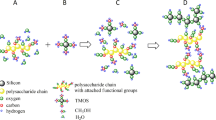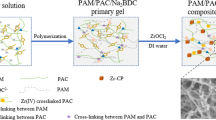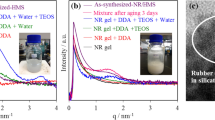Abstract
Polysaccharides and “imogolite” (a natural aluminum silicate nanoclay) were used as building blocks to prepare environmentally benign (organic/inorganic) hybrid materials of natural origin. Cellulose nanocrystals (CNCs), cellulose fibers (CFs), and sacran were employed as polysaccharides. By utilizing oppositely charged organic and inorganic components, polysaccharide/imogolite hybrids were prepared by spin-assisted layer-by-layer assembly and solution blending. The fine dispersion and attractive interactions of imogolite with polysaccharides afforded hybrids with improved physicochemical properties.
This is a preview of subscription content, access via your institution
Access options
Subscribe to this journal
Receive 12 print issues and online access
$259.00 per year
only $21.58 per issue
Buy this article
- Purchase on Springer Link
- Instant access to full article PDF
Prices may be subject to local taxes which are calculated during checkout







Similar content being viewed by others
References
Rosenau T, Potthast A, Hell J. Cellulose science and technology: chemistry, analysis, and applications, Wiley 2018.
Kadla J, Gilbert R. Cellulose structure: a review. Cellul Chem Technol. 2000;34:197.
Rol F, Belgacem MN, Gandini A, Bras J. Recent advances in surface-modified cellulose nanofibrils. Prog Polym Sci. 2019;88:241–64.
Habibi Y. Key Advances in the chemical modification of nano-celluloses. Chem Soc Rev. 2014;43:1519–42.
Klemm D, Kramer F, Moritz S, Lindstrom T, Ankerfors M, Gray D, et al. Nanocelluloses: a new family of nature-based materials. Angew Chem Int Ed. 2011;50:5438–66.
Dong XM, Kimura T, Revol JF, Gray DG. Effects of ionic strength on the phase separation of suspensions of cellulose crystallites. Langmuir. 1996;12:2076–82.
Tang J, Sisler J, Grishkewich N, Tam KC. Functionalization of cellulose nanocrystals for advanced applications. J Colloid Interface Sci. 2017;494:397–409.
Turbak AF, Snyder FW, Sandberg KR. Microfibrillated cellulose, a new cellulose product: properties, uses, and commercial potential. J Appl Polym Sci Appl Polym Symp. 1983;37:815–23.
Isogai A. Wood nanocelluloses: fundamentals and applications as new bio-based nanomaterials. J Wood Sci. 2013;59:449–59.
Isogai A, Saito T, Fukuzumi H. TEMPO-oxidized cellulose nanofibers. Nanoscale. 2011;1:71–85.
Kose R, Mitani I, Kasai W, Kondo T. “Nanocellulose” as a single nanofiber prepared from pellicle secreted by gluconacetobacter xylinus using aqueous counter collision. Biomacromolecules. 2011;12:716–20.
Abe K, Iwamoto S, Yano H. Obtaining cellulose nanofibers with a uniform width of 15 nm from wood. Biomacromolecules. 2007;8:3276–8.
Samir MASA, Alloin F, Dufresne A. Review of recent research into cellulosic whiskers, their properties and their application in nanocomposite field. Biomacromolecules. 2005;6:612–26.
Fujisawa S. Material design of nanocellulose/polymer composites via Pickering emulsion templating. Polym J. 2021;53:103–9.
Gabr MH, Phong NT, Abdelkareem MA, Okubo K, Uzawa K, Kimpara I, et al. Mechanical, thermal, and moisture absorption properties of nano-clay reinforced nano-cellulose biocomposites. Cellulose. 2013;20:819–26.
Okajima MK, Bamba T, Kaneso Y, Hirata K, Fukusaki E, Kajiyama SI, et al. Supergiant ampholytic sugar chains with imbalanced charge ratio form saline ultra-absorbent hydrogels. Macromolecules. 2008;41:4061–4.
Okajima MK, Kaneko D, Mitsumata T, Kaneko T, Watanabe J. Cyanobacteria that produce megamolecules with efficient self-orientations. Macromolecules. 2009;42:3057–62.
Cradwick PDG, Farmer VC, Russell JD, Masson CR, Wada K, Yoshinaga N. Imogolite, a hydrated aluminium silicate of tubular structure. Nat Phys Sci. 1972;240:187–9.
Yoshinaga N, Aomine S. Imogolite in some ando soils. Soil Sci Plant Nutr. 1962;8:22–9.
Ma W, Higaki Y, Takahara A. Imogolite polymer nanocomposites, Elsevier 2016, Vol. 7, pp 628–71.
Yamamoto K, Otsuka H, Takahara A. Preparation of novel polymer hybrids from imogolite nanofiber. Polym J. 2007;39:1–15.
Paineau E. Imogolite nanotubes: a flexible nanoplatform with multipurpose applications. Appl Sci. 1998;8:1921.
Govan J, Arancibia-Miranda N, Escudey M, Bonelli B, Tasca F. Imogolite: a nanotubular aluminosilicate: synthesis, derivatives, analogues, and general and biological applications. Mater Chem Front. 2021;5:6779–802.
Yamamoto K, Otsuka H, Wada SI, Takahara A. Surface modification of aluminosilicate nanofiber “imogolite”. Chem Lett. 2001;30:1162–3.
Ma W, Otsuka H, Takahara A. Application of imogolite clay nanotubes in organic–inorganic nanohybrid materials. J Mater Chem. 2012;22:11887–92.
Mukai M, Takahara M, Takada A, Takahara A. Preparation of (inorganic/organic) hybrid hydrogel from peptide oligomer and tubular aluminosilicate nanofiber. RSC Adv. 2021;11:4901–5.
Mukai M, Takada A, Hamada A, Kajiwara T, Takahara A. Preparation and characterization of imogolite/chitosan hybrid with pyridoxal-5’-phosphate as an interfacial modifier. RSC Adv. 2021;11:31712–6.
Jiravanichanun N, Yamamoto K, Yonemura H, Yamada S, Otsuka H, Takahara A. Fabrication of conjugated polymer hybrid thin films with radially oriented aluminosilicate nanofibers by spin-assembly. Bull Chem Soc Jpn. 2008;12:1663–8.
Li LL, Ma W, Higaki Y, Kamitani K, Takahara A. Organic-inorganic hybrid thin film fabricated by layer-by-layer assembly of the phosphorylated cellulose nanocrystal and imogolite nanotubes. Langmuir 2018;34:13361–7.
Iler RK. Multilayers of colloidal particles. J Colloid Interface Sci. 1966;21:569–94.
Lvov Y, Ariga K, Onda M, Ichinose I, Kunitake T. Alternate assembly of ordered multilayers of SiO2 and other nanoparticles and polyions. Langmuir. 1997;13:6195–203.
Serizawa T, Yamaguchi M, Akashi M. Alternating bioactivity of polymeric layer-by-Layer assemblies: anticoagulation vs procoagulation of hman blood. Biomacromolecules. 2002;3:724–31.
Mauroy C, Levard C, Moreau C, Vidal V, Rose J, Cathala B. Elaboration of cellulose nanocrystal/Ge-imogolite nanotube multilayered thin films. Langmuir. 2018;34:3386–94.
Yamamoto K, Otsuka H, Takahara A, Wada SI. Preparation of a novel (polymer/inorganic nanofiber) composite through surface modification of natural aluminosilicate nanofiber. J Adhes. 2002;78:591–602.
Inagaki N, Tomiha K, Katsuura K. Studies on the thermal degradation of phosphorus containing polymers: 7. Thermal degradation of phosphorylated poly (vinyl alcohol). Polymer. 1974;15:335–8.
Cho J, Char K, Hong JD, Lee KB. Fabrication of highly ordered multilayer films using a spin self-assembly method. Adv Mater. 2001;13:1076.
Farmer VC, Fraser AR, Tait JM. Synthesis of imogolite: a tubular aluminium silicate polymer. J Chem Soc Chem Commun. 1977;13:462–3.
Li LL, Takada A, Ma W, Fujikawa S, Ariyoshi M, Igata K, et al. Structure and properties of hybrid film fabricated by spin-assisted layer-by-layer assembly of sacran and imogolite nanotubes. Langmuir. 2020;36:1718–26.
Li LL, Ma W, Takada A, Takayama N, Takahara A. Organic–inorganic hybrid films fabricated from cellulose fibers and imogolite nanotubes. Biomacromolecules. 2019;20:3566–74.
Acknowledgements
The authors acknowledge the financial support of the JSPS Grant-in-Aid for Scientific Research (A) (Grant No. 26248053, 17H01221) and JSPS A3 Project. We acknowledge Prof. Tatsuo Kaneko and Dr. Maiko Okajima for providing the sacran sample. We also thank Dr. Akihiko Takada and Dr. Linlin Li for collaboration.
Author information
Authors and Affiliations
Corresponding author
Ethics declarations
Conflict of interest
The authors declare no competing interests.
Additional information
Publisher’s note Springer Nature remains neutral with regard to jurisdictional claims in published maps and institutional affiliations.
Rights and permissions
About this article
Cite this article
Higaki, Y., Takahara, A. Structure and properties of polysaccharide/imogolite hybrids. Polym J 54, 473–479 (2022). https://doi.org/10.1038/s41428-021-00588-7
Received:
Revised:
Accepted:
Published:
Issue Date:
DOI: https://doi.org/10.1038/s41428-021-00588-7



